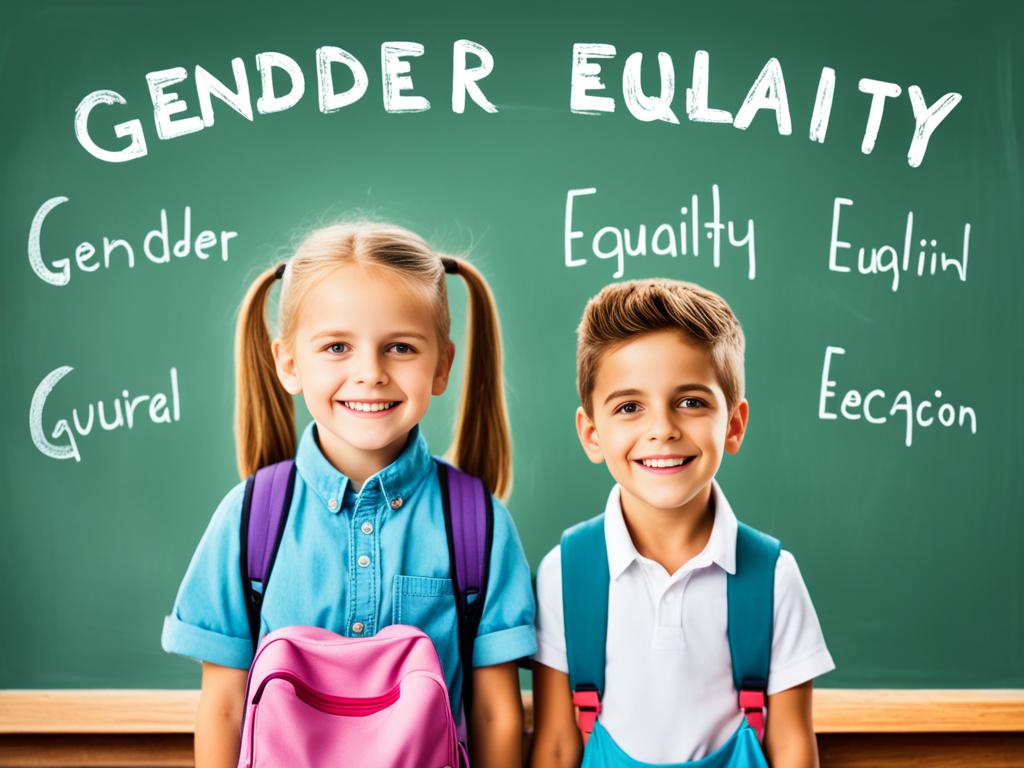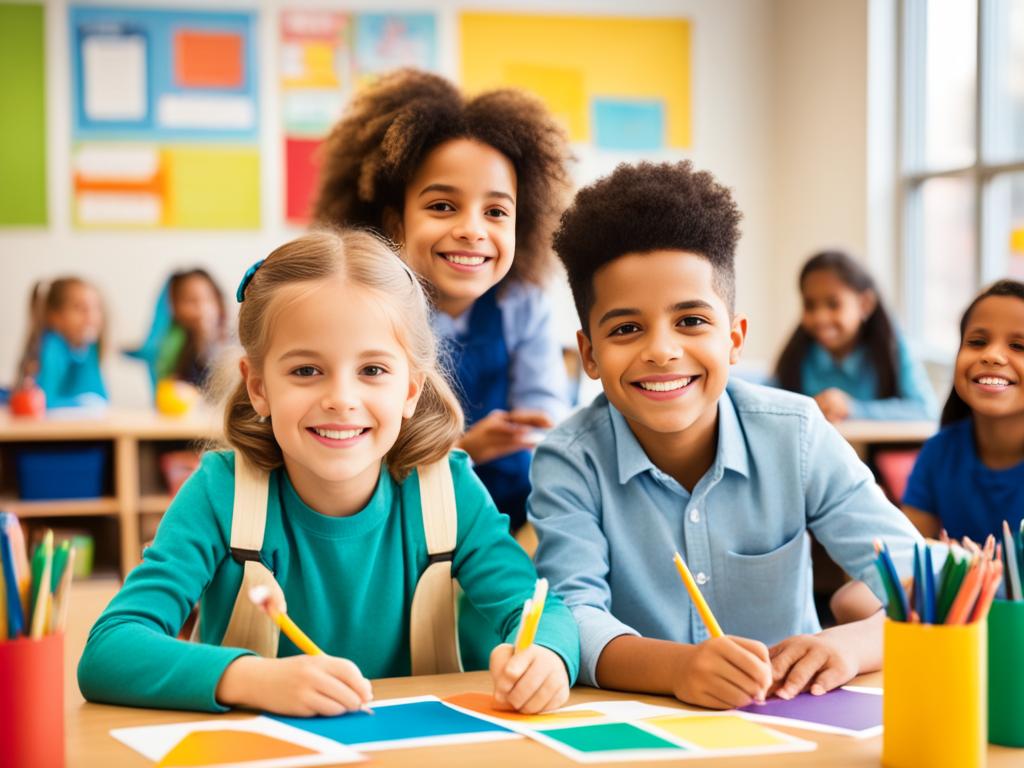
Gender Equality in Education
Education is a basic human right that helps with social progress, economic growth, and personal empowerment. Yet, achieving gender equality in education is a big challenge worldwide. Girls and women face barriers in getting into school, getting quality education, and doing well, which affects their future and society.
Gender parity is key to solving this issue. It means girls and boys have the same role in education. This not only protects their basic rights but also brings many benefits to society and the economy. When girls and women get the same education as boys, they can change the world with their skills and ideas.

But, gender discrimination and barriers stop us from reaching equal education. Girls and women face many problems, like not having good schools, violence, and gender stereotypes. These issues hurt their dreams of getting an education and a good job.
Understanding the Importance of Gender Equality in Education
Gender parity means girls and boys have the same chance to participate and be represented in education. It’s key for gender equality. It makes sure everyone has the same access to learning. This leads to big benefits for society and the economy by empowering girls and women through education.
Defining Gender Parity and Its Role in Educational Access
Gender parity means girls and boys have the same chance to join, stay in, and do well in school. When girls have the same chances as boys, they can move beyond old gender roles. This helps women gain power.
Exploring the Societal and Economic Benefits of Girls’ Education
Investing in girls’ education brings big benefits for everyone. Girls who are educated often wait longer to get married and have children. This slows down population growth and improves health for mothers and babies.
Also, women’s empowerment through education means they make more decisions at home and get involved in their communities. They also see less violence at home.
On the economic side, girls’ education helps countries grow and do better financially. Educated women work more, earn more, and help their communities and countries do better economically. This creates a cycle where the economic benefits from girls’ education help invest more in gender parity and women’s empowerment.

- Gender parity ensures equal access to educational opportunities for girls and boys.
- Educating girls and empowering women leads to societal benefits, such as lower population growth, improved maternal and child health, and reduced domestic violence.
- Investing in girls’ education boosts economic growth through increased labor force participation, higher incomes, and greater overall productivity.
Gender Discrimination and Obstacles to Inclusive Learning
Gender discrimination is a big hurdle to inclusive learning in schools. Many believe certain subjects or leadership roles are only for certain genders. This stops equal chances and representation.
School-related gender-based violence is a big problem. It includes things like mean words, hitting, and sexual attacks. This violence scares people away from learning, making them drop out or do worse in school.
- Society’s views and gender stereotypes can stop students, especially girls and non-binary people, from going after careers like science, technology, engineering, and mathematics (STEM).
- Not having enough women leaders in schools makes it seem like some careers are off-limits to certain genders.
- Bad school facilities, like poor bathrooms, can make girls and transgender students not want to go to school.
We need to tackle gender discrimination to make learning welcoming for everyone. This way, all students, no matter their gender, can do their best and succeed.

Gender Equality in Education: Policies and Initiatives
Now, making education fair for everyone is a big goal worldwide. Countries and groups see how important it is for society and the economy. They’ve started many policies and projects to fix the gender gaps and make schools more welcoming for all.
Examining National and International Policies for Gender Equity
Many governments have made laws and plans to make sure girls and boys have the same chance to learn. These gender equity policies help with scholarships, better school buildings, and support for groups left behind. The United Nations’ Sustainable Development Goal 4 is pushing the world to make education fair for everyone.
Highlighting Successful Programs and Interventions
- In India, the “Beti Bachao, Beti Padhao” campaign has helped more girls go to and stay in school. It did this by making people aware and working with communities.
- In Rwanda, the “Girls’ Education Challenge” program gave girls scholarships, mentors, and skills training. This helped them follow their dreams.
- Worldwide, Room to Read has started successful programs. They work on reading, life skills, and equality for girls and boys in poor countries.
These national and international initiatives show how working together can solve big problems in education. By looking at what works, we can keep improving and spreading good ideas. This helps make schools fairer for everyone.

Gender Equality: Implementing Gender-Responsive Pedagogy and Curricula
For true gender equality in education, we need more than just equal access. We must use gender-responsive pedagogy and curricula. These methods make learning fit the needs of all students, no matter their gender.
Fostering an Inclusive and Supportive Learning Environment
Teachers are key in making a inclusive and supportive learning environment. They can do this by:
- Fixing gender biases in what we teach and how we talk in class
- Getting all students to join in and lead
- Offering mentorship and role models, especially in STEM education for girls
- Building a classroom culture of respect, empathy, and teamwork
Gender Equality: Promoting STEM Education for Girls and Breaking Gender Stereotypes
Breaking gender stereotypes is a big part of gender-responsive teaching. It means getting more girls and young women into STEM education. We can do this by:
- Showing students women who have succeeded in STEM fields
- Creating STEM lessons that grab the interest of all students
- Offering special help and mentorship to girls and young women in STEM
- Working with families and communities to fight gender bias

With these steps, teachers can make sure all students, no matter their gender, feel empowered. They can reach their full potential in school and beyond.
Conclusion: Towards a More Equitable Future in Education
We’ve seen progress towards gender equality in education, but there’s still work to do. Together, policymakers, educators, and communities have made learning more inclusive for everyone. This has helped empower young people, no matter their gender.
Reaching gender parity in school enrollment is a big step forward. But, the real goal is to make sure every student can succeed without bias. We need to keep working on teaching methods that respect everyone’s differences and fight gender stereotypes.
Creating a welcoming learning space helps girls and women succeed in areas like STEM. This not only helps students but also boosts society and the economy. By supporting each other, we can make a better future for everyone.
FAQ
What is gender equality in education?
Gender equality in education means girls and boys, men and women all get the same chance to learn. It makes sure everyone, no matter their gender, can get good education and reach their goals.
Why is gender equality in education important?
It’s key for many reasons. It helps people, moves society forward, and opens doors for jobs. Girls and women with good education get better health, join the workforce more, and help society grow.
What are the challenges to achieving gender equality in education?
Big hurdles include cultural beliefs, social norms, and violence in schools. These stop girls and others from getting and doing well in school.
What policies and initiatives have been implemented to promote gender equity in education?
Many laws, plans, and programs are out there to fix gender gaps in school. They make sure everyone can go to school, fight gender bias, and help girls and women through education.
How can gender-responsive pedagogy and curricula improve the learning experience?
These methods make learning fit the needs of all students. They create a place where everyone feels welcome and valued. They also push for more girls in STEM fields, fighting gender stereotypes.



Gender equality is very important in education sector and otherwise.